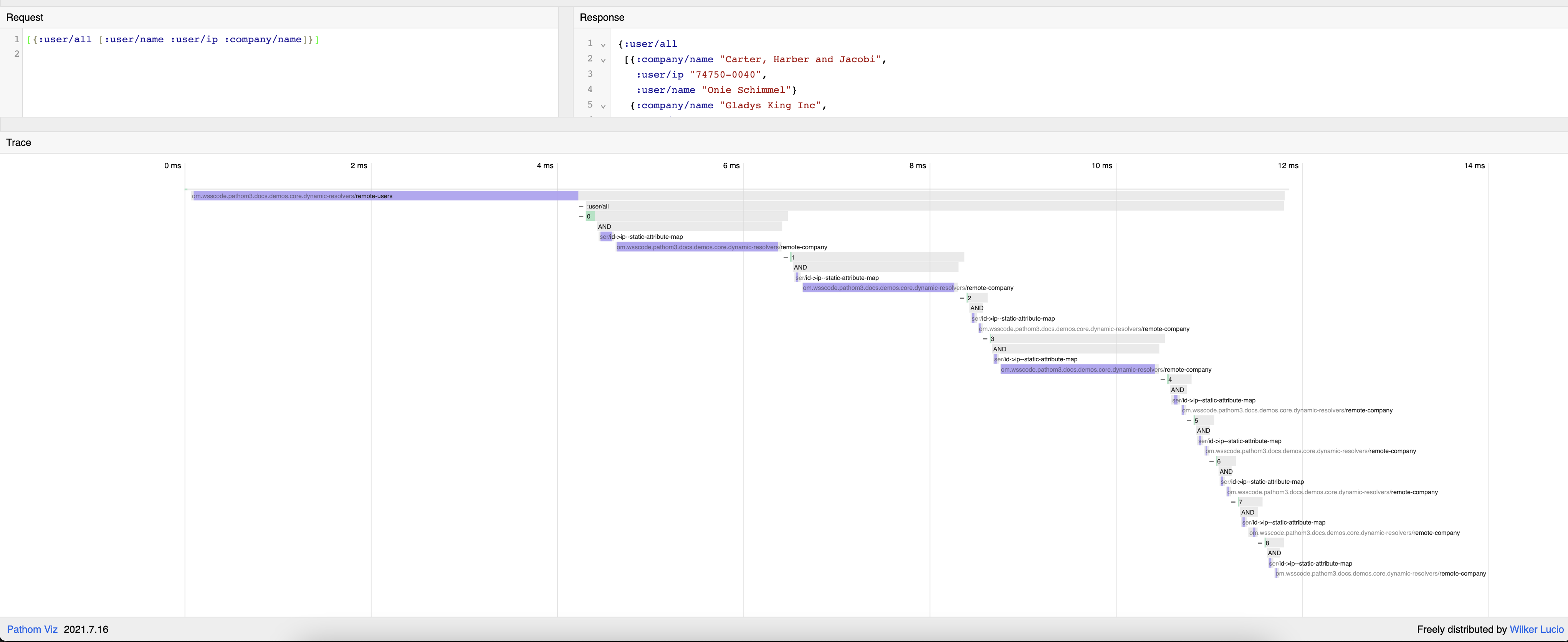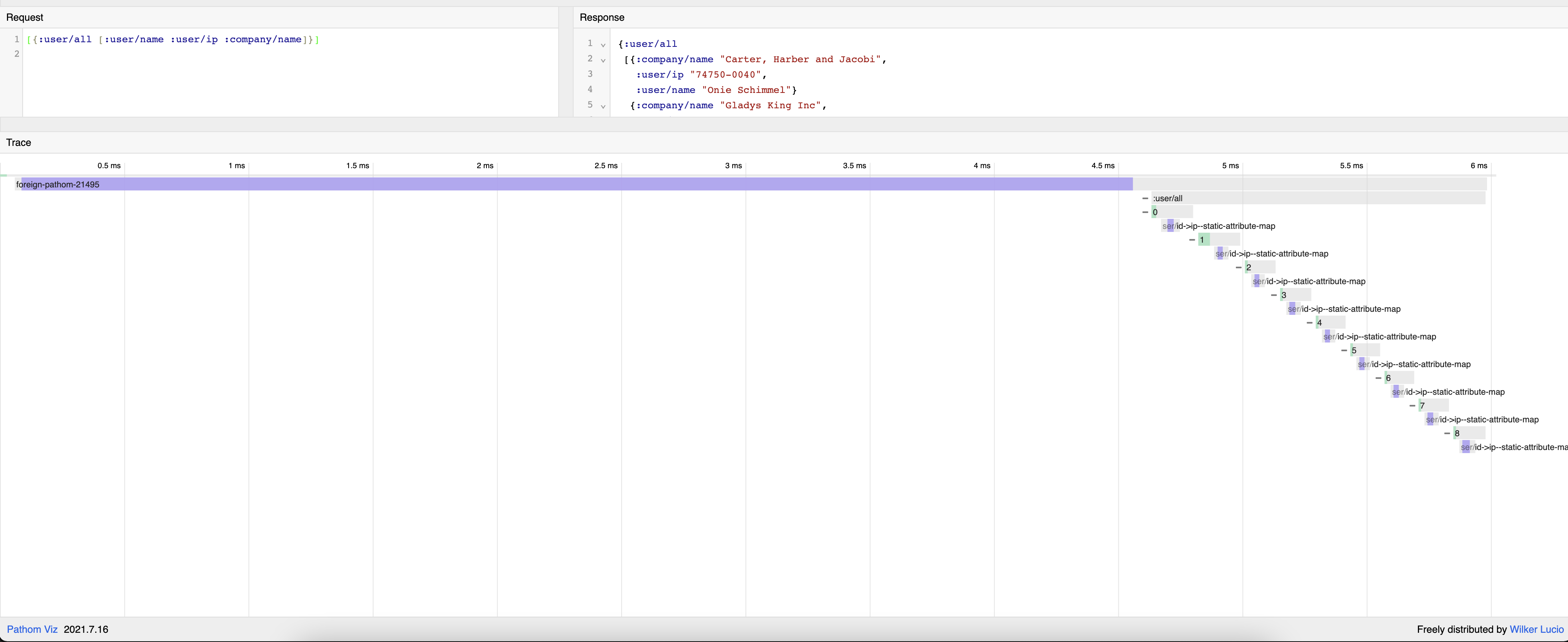Dynamic Resolvers
Dynamic resolvers feature in Pathom is currently in research/experimental stage, please avoid relying on this feature for critical parts of your system until there is time to build confidence in it.
What are dynamic resolvers?
Dynamic resolvers is a feature of Pathom that enables the definition of remote complex sources of information.
Dynamic resolvers are used for:
- Integrate a Pathom instance with another Pathom instance
- Integrate Pathom with GraphQL servers
- Integrate Pathom with Datomic
Dynamic resolvers are an advanced feature of Pathom, this page describes the motivations and how it works, but for most users you can take full advantage of dynamic resolvers using driver implementations like the ones linked before, without understand the implementation details.
What dynamic resolvers can do?
To understand the problem dynamic resolvers solve, let's first go through a manual process call a remote Pathom service.
Here is the code for the remote service:
(ns com.wsscode.pathom3.docs.demos.core.dynamic-resolvers
(:require
[com.wsscode.pathom3.connect.built-in.resolvers :as pbir]
[com.wsscode.pathom3.connect.foreign :as pcf]
[com.wsscode.pathom3.connect.indexes :as pci]
[com.wsscode.pathom3.connect.operation :as pco]
[com.wsscode.pathom3.connect.operation.transit :as pcot]
[com.wsscode.pathom3.connect.planner :as pcp]
[com.wsscode.pathom3.interface.eql :as p.eql]
[com.wsscode.transito :as transito]
[org.httpkit.client :as http]
[org.httpkit.server :as server]))
(defonce servers* (atom {}))
(defn make-server [port env]
(if-let [s (get @servers* port)]
(s))
(let [request (p.eql/boundary-interface env)
handler (fn [{:keys [body]}]
(let [req (transito/read-str (slurp body)
{:handlers pcot/read-handlers})]
{:status 200
:body (transito/write-str
(request req)
{:handlers pcot/write-handlers})}))
server (server/run-server handler
{:port port})]
(swap! servers* assoc port server)
server))
(defn http-req [port req]
(-> @(http/request
{:url (str "http://localhost:" port)
:method :post
:body (transito/write-str req {:handlers pcot/write-handlers})})
:body
slurp
(transito/read-str {:handlers pcot/read-handlers})))
(defn http-interface [port env]
(make-server port env)
#(http-req port %))
(def users-data
{1 {:user/id 1
:user/name "Christop Rippin"
:company/id 1}
2 {:user/id 2
:user/name "Miss Annabell Kessler"
:company/id 1}
3 {:user/id 3
:user/name "Demarco Padberg"
:company/id 1}
4 {:user/id 4
:user/name "Daren Wolff Jr."
:company/id 1}
5 {:user/id 5
:user/name "Carlo Schmitt"
:company/id 2}
6 {:user/id 6
:user/name "Meda Hegmann"
:company/id 2}
7 {:user/id 7
:user/name "Onie Schimmel"
:company/id 3}
8 {:user/id 8
:user/name "Mayra Raynor"
:company/id 3}
9 {:user/id 9
:user/name "Bobbie Grant"
:company/id 3}})
(def company-data
{1 {:company/id 1
:company/name "Gladys King Inc"}
2 {:company/id 2
:company/name "Funk-Stamm"}
3 {:company/id 3
:company/name "Carter, Harber and Jacobi"}})
(pco/defresolver all-users []
{::pco/output
[{:user/all
[:user/id
:user/name
:company/id]}]}
{:user/all
(vec (vals users-data))})
(pco/defresolver user-by-id [{:user/keys [id]}]
{::pco/output
[:user/name
:company/id]}
(get users-data id))
(pco/defresolver company-by-id [{:company/keys [id]}]
{::pco/output
[:company/name]}
(get company-data id))
(def env
(-> (pci/register
[all-users
user-by-id
company-by-id])
(pcp/with-plan-cache (atom {}))))
; this function will take a request and run though HTTP
(def request
(http-interface 8087 env))
Now let's consider we have a different server, and we want to consume and extend
the user data to add the :user/ip of each user.
In this case we are going get the information writing resolvers to forward some queries to our previous server.
(def ips
{1 "82949-5679"
2 "39359-0412"
3 "40703-7676"
4 "85822-1129"
5 "03074-6343"
6 "09986-9393"
7 "74750-0040"
8 "82239"
9 "81444-2468"})
(pco/defresolver remote-users
"Forward user list request to remote server"
[]
{::pco/output
[{:user/all
[:user/id
:user/name
:company/id]}]}
(request
[{:user/all
[:user/id
:user/name
:company/id]}]))
(pco/defresolver remote-company
"Forward company data request to remote server"
[{:keys [company/id]}]
{::pco/output
[:company/name]}
(request
{:pathom/entity
{:company/id id}
:pathom/eql
[:company/name]}))
(def client-env
(-> (pci/register
[remote-users
remote-company
(pbir/static-attribute-map-resolver
:user/id :user/ip ips)])
(pcp/with-plan-cache (atom {}))))
(def client-request
(p.eql/boundary-interface client-env))
With this setup we can run the following query combining the sources:
(client-request
[{:user/all
[:user/name
:user/ip
:company/name]}])
; {:user/all [{:user/name "Onie Schimmel",
; :user/ip "74750-0040",
; :company/name "Carter, Harber and Jacobi"}
; {:user/name "Christop Rippin",
; :user/ip "82949-5679",
; :company/name "Gladys King Inc"}
; {:user/name "Daren Wolff Jr.",
; :user/ip "85822-1129",
; :company/name "Gladys King Inc"}
; {:user/name "Meda Hegmann",
; :user/ip "09986-9393",
; :company/name "Funk-Stamm"}
; {:user/name "Demarco Padberg",
; :user/ip "40703-7676",
; :company/name "Gladys King Inc"}
; {:user/name "Miss Annabell Kessler",
; :user/ip "39359-0412",
; :company/name "Gladys King Inc"}
; {:user/name "Bobbie Grant",
; :user/ip "81444-2468",
; :company/name "Carter, Harber and Jacobi"}
; {:user/name "Carlo Schmitt",
; :user/ip "03074-6343",
; :company/name "Funk-Stamm"}
; {:user/name "Mayra Raynor",
; :user/ip "82239",
; :company/name "Carter, Harber and Jacobi"}]}
It works! But there are several inefficiencies in this process. For start let's look at the trace graph from this query:

The trace show us that to complete this request, it called the remote server four times. One for the users, plus one per company (given we have 3 different companies).
Some key points:
- We have to manually integrate each resolver, which means every change on the server might require changes on the clients
- Excessive round trips, which adds significant overhead
Now try to imagine how this would scale, with hundreds of resolvers and maybe multiple services.
That's were dynamic resolvers come in. Dynamic resolvers can leverage the planning algorithms of Pathom to calculate a request to an external service. When we think about Pathom integrating with Pathom, this translates as having the external index, but instead of processing it locally, its filtered and send to a remote service.
Let's redo our client code, but this time using the foreign Pathom feature, which provides tools to integrate a Pathom system with another:
(def ips
{1 "82949-5679"
2 "39359-0412"
3 "40703-7676"
4 "85822-1129"
5 "03074-6343"
6 "09986-9393"
7 "74750-0040"
8 "82239"
9 "81444-2468"})
(def client-env
(-> (pci/register
[; we use foreign-register which takes a function with a request, like the
; one we used to make the manual requests internally
(pcf/foreign-register request)
(pbir/static-attribute-map-resolver
:user/id :user/ip ips)])
(pcp/with-plan-cache (atom {}))))
(def client-request
(p.eql/boundary-interface client-env))
Now let's run the same query and check the trace:

Note this time there was only a single request sent to the remote server. To handle this Pathom is taking the query and the remote server in consideration to find the optimal query to request, reducing the round trips.
How dynamic resolvers work
Dynamic resolvers have two main parts.
The first is the dynamic resolver itself, it's like a normal resolver, but with
::pco/dynamic-resolver? true. One difference from static resolvers, is that dynamic resolvers
will also include a foreign ast. This AST describes the request for the dynamic
resolver to use.
The second part are auxiliar resolvers. Those resolvers don't have an implementation,
they are used to calculate the sub-query to send to the dynamic resolver.
We can make an adaptation of our previous manual example to implement it using dynamic resolvers:
(def remote-dynamic-resolvers
[; 1 - the main resolver
(pco/resolver 'remote-dynamic
{::pco/dynamic-resolver? true}
(fn [env input]
(request
{:pathom/ast (-> env ::pcp/node ::pcp/foreign-ast)
:pathom/entity input})))
; 2 - the auxiliary resolvers, note they reference the main one
(pco/resolver 'remote-user-by-id
{::pco/input [:user/id]
::pco/output [:user/name :company/id]
::pco/dynamic-name 'remote-dynamic})
(pco/resolver 'remote-company-by-id
{::pco/input [:company/id]
::pco/output [:company/name]
::pco/dynamic-name 'remote-dynamic})])
(def client-env2
(-> (pci/register
[remote-dynamic-resolvers
(pbir/static-attribute-map-resolver
:user/id :user/ip ips)])
(pcp/with-plan-cache (atom {}))))
(def client-request2
(p.eql/boundary-interface client-env2))
We did a little change, we are going to get information from a single users, so it's simpler to inspect:
(client-request2
{:pathom/entity
{:user/id 1}
:pathom/eql
[:user/name
:user/ip
:company/name]})
In the following component you can see the final plan, and the steps to get to it.
Try going back to the === Optimize === path, where you will be able to see three
nodes for remote-dynamic.
Use the combobox on the left to switch between displaying the node resolver name and the node id.
The merge at the step Merge chained same dynamic resolvers. is one interesting to note.
In this case the first node will get the :company/id from the :user/id, the second
will use the :company/id to fetch the :company/name.
In this situation, Pathom understands that this dynamic source already know about
the middle transitions, so we can remove the middle parts. This results in an end
node that will have :user/id as input and :company/name as the output, skipping
the :company/id fetch part.
A different kind of merging happens at the step Merging sibling resolver calls to resolver remote-dynamic.
This time is different, it's a sibling relationship merge. In this case Pathom merges the foreign ast of the nodes, combining then in a single request.
Click on the nodes in the graph to see their data details, you can follow how they change at each step of the graph definition.
Other data sources
The previous example demonstrates how Pathom uses dynamic resolvers to combine request demands of a foreign source.
One important thing to note is that the dynamic resolver idea is not be strict to Pathom usages. Instead, you can think of a generic solution for sources that could support this kind of request, or something adaptive.
The simplest example that supports this kind of shape query is GraphQL.
We can also use a shape like this to translate to other formats like SQL. The Walkable library is a good example on how to translate a shape request into something that's not native adaptive to it, like SQL.
GraphQL
The library Pathom 3 GraphQL has an implementation to incorporate GraphQL data sources into the Pathom system. Learn more at the GraphQL tutorial.